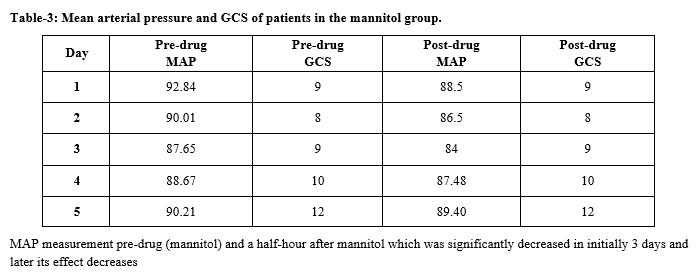Compare the efficacy of hypertonic saline vs mannitol as an anti-edema measure, in cases of head injury
Abstract
Background: To study the efficacy and safety of 3% hypertonic saline and compare with 20% mannitol in the management of moderate to severe head injury.
Material and Methods: Group A (patients treated with Mannitol) n=30, Group B (patients treated with 3% hypertonic saline) n=30. Intervention protocol Dose of Mannitol 20% 2ml/Kg infused over 20 minutes 6 or 8 hourly for the group A. Group B infused with 3% 2ml/Kg Hypertonic Saline over 20 minutes. Safety and efficacy compared.
Results: There was no significant difference in mortality. The duration of coma hours was also not very different. There was no difference in the neurological outcomes of both groups. No significant untoward complications observed in both the groups which were found to be related to the drug. hypertonic saline (3%) therapy in case of moderate to severe head injury is found to be as safe and as efficacious as mannitol. No significant hypernatremia is seen in 97% of our patients of hypertonic saline (3%) group.
Conclusion: In our comparative prospective study, it can be concluded that the efficiency of 20% Mannitol and 3% Hypertonic Saline for the treatment of cerebral edema in patients with moderate to severe head injury is almost equal.
Downloads
References
Upadhyay P, Tripathi VN, Singh RP, Sachan D. Role of hypertonic saline and mannitol in the management of raised intracranial pressure in children: A randomized comparative study. J Pediatr Neurosci. 2010;5 (1):18-21.doi: https://dx.doi.org/10.41032F1817-1745.66673.
Ziai WC, Toung TJ, Bhardwaj A.Hypertonic saline: first-line therapy for cerebral edema?. J Neurol Sci. 2007;261 (1-2):157-166.doi: https://doi.org/10.1016/j.jns.2007.04.048.
Kheirbek T, Pascual JL. Hypertonic saline for the treatment of intracranial hypertension. Curr Neurol Neurosci Rep. 2014;14(9):482.doi: https://doi.org/10.1007/s11910-014-0482-4.
Mendelow AD, Teasdale GM, Russell T, Flood J, Patterson J, Murray GD. Effect of mannitol on cerebral blood flow and cerebral perfusion pressure in human head injury. J Neurosurg. 1985;63(1):43-48.doi: https://doi.org/10.3171/jns.1985.63.1.0043.
Wakai A, Roberts IG, Schierhout G. Mannitol for acute traumatic brain injury. Cochrane Database Syst Rev. 2005(4).doi: https://doi.org/10.1002/14651858.cd001049.pub4.
Smith HP, Kelly DL, McWhorter JM, Armstrong D, Johnson R, Transou C, et al. Comparison of mannitol regimens in patients with severe head injury undergoing intracranial monitoring. J Neurosurg. 1986;65 (6):820-824.doi: https://doi.org/10.3171/jns.1986.65.6.0820.
Toung TJ, Chang Y, Lin J, Bhardwaj A. Increases in lung and brain water following experimental stroke: effect of mannitol and hypertonic saline. Crit Care Med. 2005;33 (1):203-208. doi: https://doi.org/10.1097/01.ccm.0000150659.15558.23.
Toung TJ, Chen CH, Lin C, Bhardwaj A. Osmotherapy with hypertonic saline attenuates water content in brain and extracerebral organs. Crit Care Med. 2007;35 (2):526-531.doi: https://doi.org/10.1097/01.ccm.0000253309.44567.a6.
Boas WW, Marques MB, Alves A. Hydroelectrolytic balance and cerebral relaxation with hypertonic isoncotic saline versus mannitol (20%) during elective neuroanesthesia. Rev Brazil JAnesthesiol. 2011;61 (4):456-468.doi: https://doi.org/10.1016/s0034-7094(11)70053-8.
Raghava A, Bidkar PU, Prakash MS, Hemavathy B. Comparison of equiosmolar concentrations of hypertonic saline and mannitol for intraoperative lax brain in patients undergoing craniotomy. Surg Neurol Int. 2015;6:73.doi: https://dx.doi.org/10.4103%2F2-1527806.156771.
Malik ZA, Mir SA, Naqash IA, Sofi KP, Wani AA. A prospective, randomized, double blind study to compare the effects of equiosmolar solutions of 3% hypertonic saline and 20% mannitol on reduction of brain-bulk during elective craniotomy for supratentorial brain tumor resection. Anesth Essays Res. 2014;8 (3):388-392.doi: https://doi.org/10.4103/0259-1162.143155.
Zachariades N, Papavassiliou D. The pattern and aetiology of maxillofacial injuries in Greece: a retrospective study of 25 years and a comparison with other countries. JCranioMaxillofac Surg. 1990;18 (6): 251-254.doi: https://doi.org/10.1016/s1010-5182(05)80425-1.

Copyright (c) 2020 Author (s). Published by Siddharth Health Research and Social Welfare Society

This work is licensed under a Creative Commons Attribution 4.0 International License.


 OAI - Open Archives Initiative
OAI - Open Archives Initiative


















 Therapoid
Therapoid

